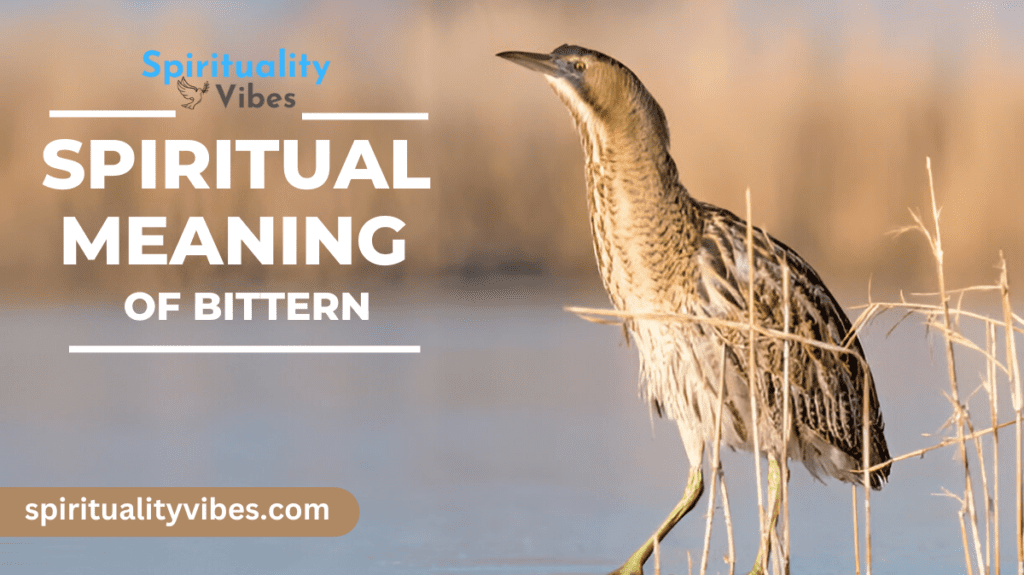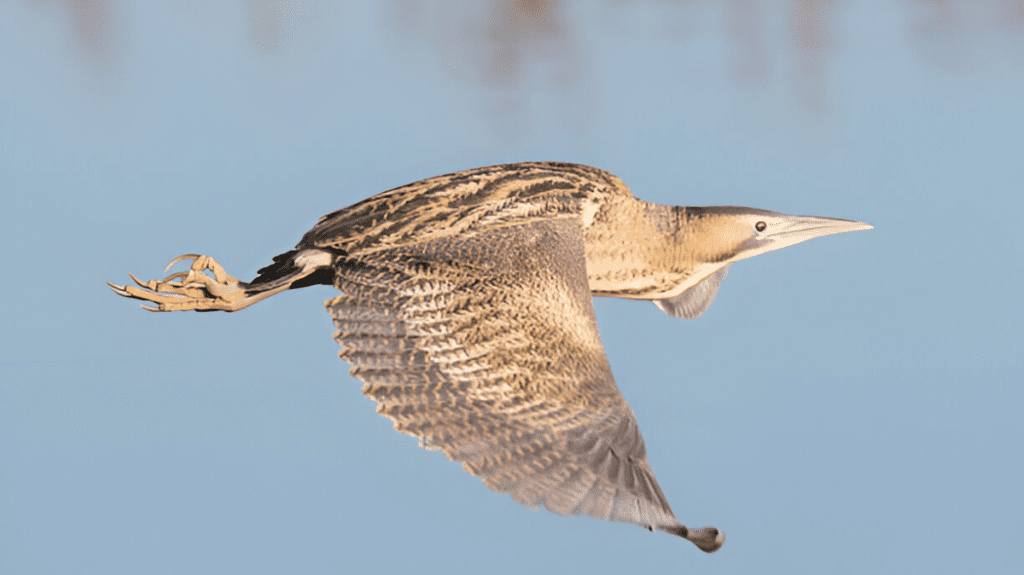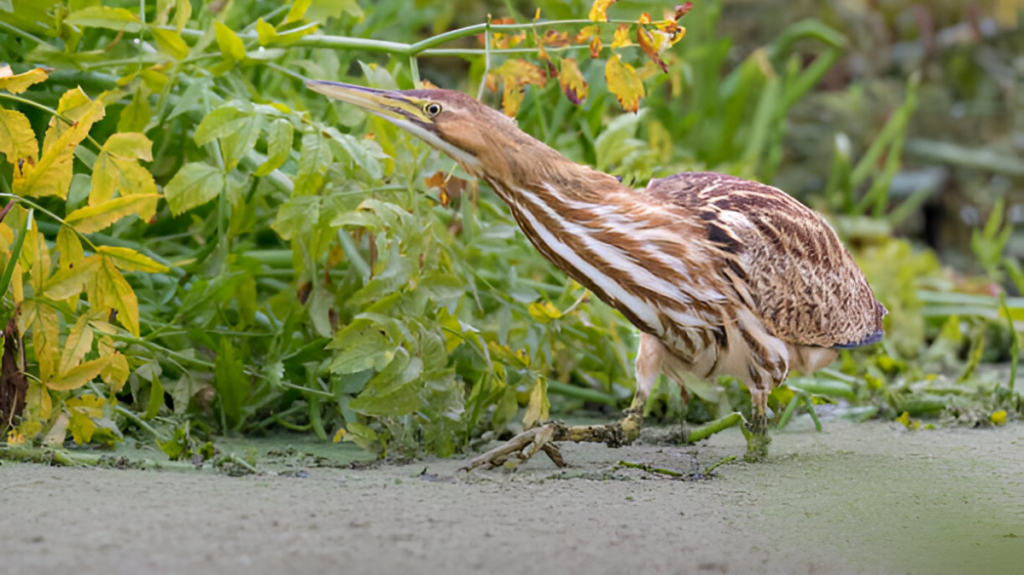Bitterns are fascinating birds that hold a special place in the natural world. Before we dive into their spiritual significance, let’s take a moment to understand what these creatures are and how they live in nature.
This knowledge will help you appreciate the deeper meanings associated with bitterns.

Contents
- 1 Overview of Bittern Symbolism
- 2 Importance of Bittern in Spirituality
- 3 Meaning and Messages of Bittern
- 4 Types of Bittern and Their Meanings
- 5 Historical Context
- 6 Spiritual Signs
- 7 Spiritual Characteristics
- 8 Symbolism in Different Cultures
- 9 Positive Traits
- 10 Negative Traits
- 11 Totem or Spirit Animals
- 12 Dream Interpretation
- 13 Mythology and Folklore
- 14 Tattoos and Their Meanings
- 15
Overview of Bittern Symbolism
Bitterns are nature’s great secret-keepers. They blend in so well with the reeds and grasses that you might walk right past one without seeing it.
This amazing ability to hide teaches us about the power of being still and quiet. Sometimes, the most important things in life are not easy to see at first.
The bittern’s call is another special thing about it. It makes a deep, booming sound that carries far across the wetlands. This reminds us that even when we feel invisible, our voice can still be strong and important.
In the spirit world, bitterns are seen as wise teachers. They show us how to find balance between being seen and unseen, between speaking up and staying quiet. They remind us that true strength often comes from within and doesn’t always need to be shown off.
Importance of Bittern in Spirituality
Bitterns live where water meets land. This makes them very special in spiritual thinking. Water often represents our feelings and dreams, while land stands for our everyday life and practical thoughts. By living in both worlds, bitterns teach us how to balance our inner dreams with our outer lives.
Many spiritual thinkers believe bitterns can help us understand hidden truths. Just like how bitterns can see fish underwater that we can’t spot, they might help us see things about ourselves or the world that we usually miss.
Bitterns are also patient hunters. They can stand still for a very long time, waiting for the right moment to catch a fish. This patience is a big spiritual lesson. It teaches us that good things come to those who wait and stay focused on what’s important.
Meaning and Messages of Bittern
When a bittern shows up in your life, even if it’s just in a picture or a dream, it might be carrying a special message for you. Here are some things the bittern might be trying to tell you:
- Be patient: Good things take time. Don’t rush.
- Trust your instincts: You know more than you think you do.
- Find your own path: It’s okay to be different from others.
- Look deeper: There’s often more to a situation than what you see at first.
- Stand your ground: Like a bittern in the reeds, you are stronger than you know.
Lessons from the Bittern
Bitterns have many lessons to teach us if we pay attention:
- Blend in when needed: Sometimes it’s wise to step back and observe.
- Speak up when it matters: Your voice is powerful, use it wisely.
- Stay focused: Keep your eyes on what’s important to you.
- Adapt to your surroundings: Be flexible and ready to change.
- Value solitude: Quiet time alone can help you grow stronger.
Types of Bittern and Their Meanings
Bitterns are a group of wading birds in the heron family, Ardeidae. They are known for their cryptic plumage and secretive nature, often blending seamlessly into their reed bed habitats. Here’s a detailed look at various bittern species:
Great Bittern (Botaurus stellaris)
The Great Bittern, also known as Eurasian Bittern, is a large wading bird found in parts of Europe, Asia, and Africa.
- Appearance: It has a thick-set body with brown and buff streaked plumage, providing excellent camouflage in reeds.
- Behavior: Known for its distinctive booming call, which can be heard up to 5 km away.
- Habitat: Primarily found in dense reed beds and marshlands.
- Conservation: Listed as ‘Least Concern’ globally, but faces threats due to habitat loss in some regions.
American Bittern (Botaurus lentiginosus)
This species is native to North and Central America.
- Appearance: Similar to the Great Bittern but slightly smaller, with a more streaked neck and underparts.
- Behavior: Famous for its “pump-er-lunk” call, reminiscent of an old-fashioned water pump.
- Habitat: Freshwater wetlands and dense, tall vegetation near water bodies.
- Conservation: Currently listed as ‘Least Concern’, but populations are declining due to wetland drainage.
Australasian Bittern (Botaurus poiciloptilus)
Found in southern Australia, New Zealand, and New Caledonia.
- Appearance: Very similar to the Great Bittern, with subtle differences in plumage patterns.
- Behavior: Extremely secretive, rarely seen in the open.
- Habitat: Freshwater wetlands with tall, dense vegetation.
- Conservation: Listed as ‘Endangered’ due to significant population decline and habitat loss.
Pinnated Bittern (Botaurus pinnatus)
Native to the Americas, ranging from southern Mexico to northern Argentina.
- Appearance: Slightly smaller than the American Bittern, with a more uniform brown coloration.
- Behavior: Less vocal than other bitterns, with a softer, more guttural call.
- Habitat: Tropical and subtropical wetlands, including marshes and swamps.
- Conservation: Listed as ‘Least Concern’, but facing pressure from habitat destruction.
Little Bittern (Ixobrychus minutus)
A small bittern species found in parts of Europe, Africa, and Asia.
- Appearance: Much smaller than the Botaurus bitterns, with contrasting black and buff plumage in males.
- Behavior: More active during twilight hours, often climbing reed stems.
- Habitat: Dense reed beds and other aquatic vegetation in various wetland habitats.
- Conservation: Listed as ‘Least Concern’ globally, but declining in some European countries.
Yellow Bittern (Ixobrychus sinensis)
Widely distributed across Asia and parts of Australasia.
- Appearance: Small, with predominantly yellow-buff plumage and dark flight feathers.
- Behavior: Often more visible than other bitterns, sometimes seen perching in the open.
- Habitat: Various wetland types, including rice paddies and mangroves.
- Conservation: Listed as ‘Least Concern’, adapting well to some human-modified habitats.
Black Bittern (Ixobrychus flavicollis)
Found in parts of South Asia, Southeast Asia, and Australia.
- Appearance: Larger than other Ixobrychus bitterns, with dark plumage and a distinctive yellow neck patch.
- Behavior: More crepuscular and nocturnal in habits.
- Habitat: Wooded wetlands, mangroves, and densely vegetated water bodies.
- Conservation: Listed as ‘Least Concern’, but facing localized threats from habitat loss.
Least Bittern (Ixobrychus exilis)
The smallest bittern in the Americas, found from southern Canada to northern Argentina.
- Appearance: Tiny, with contrasting dark and light plumage patterns.
- Behavior: Extremely secretive, often freezing in place when threatened.
- Habitat: Dense marshes and wetlands with tall vegetation.
- Conservation: Listed as ‘Least Concern’, but vulnerable to wetland habitat loss.
Dwarf Bittern (Ixobrychus sturmii)
A small bittern native to sub-Saharan Africa.
- Appearance: Small and compact, with mottled brown plumage.
- Behavior: More terrestrial than other bitterns, often found away from water.
- Habitat: Grasslands, savannas, and lightly wooded areas, often near seasonal wetlands.
- Conservation: Listed as ‘Least Concern’, with a wide distribution across Africa.
Historical Context
Bitterns have been part of human culture and history for a long time. Understanding how people viewed these birds in the past can give us insight into their spiritual significance today.
Bitterns in Ancient Cultures
Long ago, many cultures thought the bittern was a magical bird. In some places, people believed that bitterns could predict the weather. They thought that when a bittern made its deep, booming call, it meant rain was coming.
This shows how people have always felt there was something special about these birds.
Bitterns in Historical Texts
Bitterns appear in old stories and books from different parts of the world. In some Christian writings, the bittern is mentioned as a bird that lives in lonely places.
This added to the idea that bitterns were mysterious and perhaps a little spooky.
Spiritual Signs
Many people believe that animals can bring us messages from the spiritual world. Bitterns, with their mysterious nature, are often seen as powerful spiritual messengers.
Encountering a Bittern
If you ever see a bittern, it might be more than just luck. In spiritual thinking, meeting an animal can be a sign or a message.
Seeing a bittern could mean it’s time to pay attention to the quiet voice inside you. It might be telling you to trust your instincts and look for the hidden truths in your life.
Signs and Omens
Some people believe that animals can bring us messages from the spirit world. If a bittern keeps showing up in your life, in real life or in dreams, it could be a sign. Maybe it’s telling you to be patient or to look for answers in unexpected places.
Spiritual Characteristics
Bitterns have unique traits and behaviors that give them special meaning in the spiritual world. These characteristics can teach us important lessons about life and ourselves.
Unique Traits of the Bittern
Bitterns have some cool traits that make them special in the spiritual world. They can stand still for a very long time, which shows great focus. They’re also really good at blending in with their surroundings.
These traits can teach us about the power of concentration and how sometimes it’s okay to just blend in and observe.
Bittern’s Behavior
The way bitterns act can teach us a lot. They’re most active at dawn and dusk, times when the day is changing. This reminds us that change is a natural part of life.
Bitterns are also very careful and take their time. They show us that it’s okay to move slowly and think things through.
Symbolism in Different Cultures
The bittern’s symbolism isn’t the same everywhere. Different cultures have their own ideas about what these birds represent. Let’s explore how bitterns are viewed in various traditions around the world.
Bittern in Various Traditions
Different cultures around the world have their own ideas about bitterns. In some places, they’re seen as wise birds that know secrets about nature.
In others, they’re thought to be a bit spooky because of the strange sounds they make. These different views show how one animal can mean many things to different people.
Eastern and Western Views
In some Eastern cultures, bitterns are seen as symbols of patience and calm. They’re admired for their ability to wait quietly for the right moment.
In Western traditions, bitterns are often linked to mystery and hidden knowledge. Both views teach us to value the bittern’s quiet strength.

Positive Traits
Bitterns have many positive qualities that we can learn from and try to incorporate into our own lives. These traits can help us become better, more balanced individuals.
Strengths of the Bittern
Bitterns have many good qualities that we can learn from. They’re patient, focused, and good at adapting to their surroundings. These birds also show us the importance of being observant and waiting for the right moment to act.
Embracing These Traits
We can try to be more like the bittern in our own lives. This means being patient when things are tough, staying focused on what’s important, and learning to adapt when things change. It also means taking time to watch and listen before we act.
Negative Traits
While bitterns have many positive qualities, they can also represent some challenges. It’s important to consider these aspects to get a full understanding of the bittern’s spiritual meaning.
Challenges Represented by the Bittern
While bitterns have many good qualities, they can also remind us of some challenges. Because they’re so good at hiding, bitterns might make us think about times when we hide our true selves from others. They might also represent being too shy or afraid to speak up.
Overcoming Negative Aspects
We can learn from these challenges too. Sometimes it’s good to blend in, but we shouldn’t always hide who we are. The bittern teaches us to find a balance between staying safe and being true to ourselves. It’s okay to be quiet, but we should also know when it’s time to let our voices be heard.
Totem or Spirit Animals
In many spiritual traditions, animals are seen as guides or protectors. The bittern, with its unique qualities, can be a powerful totem or spirit animal for some people.
Bittern as a Totem
A totem is an animal spirit that guides and protects us. If the bittern is your totem, it means you have a special connection with this bird. People with a bittern totem are often good at keeping secrets and finding hidden truths. They’re also patient and observant, just like the bittern.
Guidance from the Bittern
The bittern totem can guide us in many ways. It teaches us to trust our instincts and to look beyond what we can see on the surface. The bittern reminds us that sometimes the best action is no action at all – just watching and waiting for the right moment.
Dream Interpretation
Dreams can be a window into our subconscious minds. When a bittern appears in our dreams, it often carries special meanings and messages.
Seeing a Bittern in Dreams
Dreams about bitterns can have special meanings. If you see a bittern in your dream, it might be telling you to pay attention to the quiet parts of your life. It could mean that there’s something important you’re not noticing when you’re awake.
Analyzing Bittern Dreams
When you dream about a bittern, think about what the bird was doing. Was it hiding? That might mean you’re keeping a secret or hiding part of yourself.
Was it standing still? Maybe you need to be more patient in your life. Dreams can give us clues about our feelings and what’s going on in our lives.
Mythology and Folklore
Bitterns have appeared in stories and legends for centuries. These tales can give us insight into how different cultures have viewed these mysterious birds over time.
Legends Involving Bitterns
There are many old stories about bitterns. In some tales, they’re seen as magical birds that can disappear into thin air.
Other stories say that bitterns can call up the rain or predict storms. These legends show how people have always been fascinated by these mysterious birds.
The Bittern in Mythical Contexts
In some myths, bitterns are connected to the spirit world. They’re sometimes seen as messengers between our world and the world of spirits. This idea comes from the bittern’s ability to appear and disappear so easily in its habitat.

Tattoos and Their Meanings
In modern times, some people choose to express their connection to the bittern through tattoos. These permanent symbols can carry deep personal meanings.
Bittern Tattoo Symbolism
Some people choose to get tattoos of bitterns. These tattoos can have different meanings. They might represent patience, the ability to blend in, or a connection to nature. A bittern tattoo could also mean that the person values quiet strength and wisdom.
Cultural Influence on Tattoos
The meaning of a bittern tattoo can change depending on the culture. In some places, it might be seen as a symbol of good luck or protection. In others, it could represent the ability to keep secrets or to see hidden truths. The design of the tattoo can also add to its meaning.
In conclusion, the bittern is a bird that has captured people’s imagination for a long time. Its ability to blend in with its surroundings and its patient nature have made it a powerful symbol in many cultures.
The bittern teaches us valuable lessons about patience, observation, and finding hidden truths.
Whether we see the bittern as a spiritual guide, a dream symbol, or just an interesting bird, it has much to teach us. It reminds us to slow down, to look closely at the world around us, and to trust our inner wisdom.
The bittern shows us that there’s strength in being quiet and that sometimes the most important things are hidden from view.
By learning from the bittern, we can become more patient, more observant, and more in tune with the world around us. We can learn to value the quiet moments in life and to look for the deeper meanings in what we see and experience.
What does it mean if I see a bittern?
Seeing a bittern might be a sign to pay attention to the quiet parts of your life. It could be telling you to be patient or to look for hidden truths.
Are bitterns considered lucky?
In some cultures, bitterns are seen as lucky birds. They’re often connected with wisdom and the ability to see what others can’t.
What should I do if the bittern is my spirit animal?
If the bittern is your spirit animal, try to practice patience and observation in your daily life. Pay attention to the quiet moments and trust your instincts.
Can bitterns really predict the weather?
While there’s no scientific proof, many old stories say that bitterns can predict rain. This belief probably came from people noticing that bitterns call more often before it rains.
Why are bitterns so good at hiding?
Bitterns have feathers that look like the reeds and grasses where they live. They can also stand very still with their beaks pointed up, making them look just like the plants around them.
